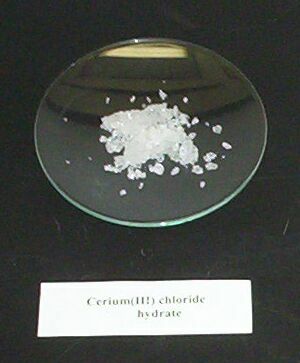Top Qs
Timeline
Chat
Perspective
Cerium(III) chloride
Chemical compound From Wikipedia, the free encyclopedia
Remove ads
Cerium(III) chloride (CeCl3), also known as cerous chloride or cerium trichloride, is a compound of cerium and chlorine. It is a white hygroscopic salt; it rapidly absorbs water to form hydrates, which may be of variable composition.The hexa- and heptahydrate CeCl3·7H2O are known.[1] All forms are highly soluble in water, and the anhydrous derivative is soluble in ethanol and acetone.[2][3]
Remove ads
Preparation of anhydrous CeCl3
Simple rapid heating of the hydrate alone may cause small amounts of hydrolysis.[4]
A useful form of anhydrous CeCl3 can be prepared if care is taken to heat the heptahydrate gradually to 140 °C (284 °F) over many hours under vacuum.[2][5][6] This may or may not contain a little CeOCl from hydrolysis, but it is suitable for use with organolithium and Grignard reagents. Pure anhydrous CeCl3 can be made by dehydration of the hydrate either by slowly heating to 400 °C (752 °F) with 4–6 equivalents of ammonium chloride under high vacuum,[4][7][8][9] or by heating with an excess of thionyl chloride for three hours.[4][10] The anhydrous halide may alternatively be prepared from cerium metal and hydrogen chloride.[11][12] It is usually purified by high temperature sublimation under high vacuum. Soxhlet extraction of CeCl3 with thf gives CeCl3(thf)1.04.[13]
Remove ads
Uses
Cerium(III) chloride can be used as a starting point for the preparation of other cerium salts, such as the Lewis acid cerium(III) trifluoromethanesulfonate.[14]
Organic synthesis
Cerium(III) chloride is a reagent in several procedures used in organic synthesis.[15] Luche reduction[16] of alpha, beta-unsaturated carbonyl compounds has become a popular method in organic synthesis, where CeCl3·7H2O is used in conjunction with sodium borohydride. For example, carvone gives only the allylic alcohol 1 and none of the saturated alcohol 2. Without CeCl3, a mixture of 1 and 2 is formed.
It can also deprotect MEM group to alcohol in the presence of other acetal protecting groups (e.g. THP.)
Another important use in organic synthesis is for alkylation of ketones, which would otherwise form enolates if simple organolithium reagents were to be used. For example, compound 3 would be expected to simply form an enolate without CeCl3 being present, but in the presence of CeCl3 smooth alkylation occurs: [5]
It is reported that organolithium reagents work more effectively in this reaction than do Grignard reagents.[5]
Remove ads
References
Further reading
Wikiwand - on
Seamless Wikipedia browsing. On steroids.
Remove ads








